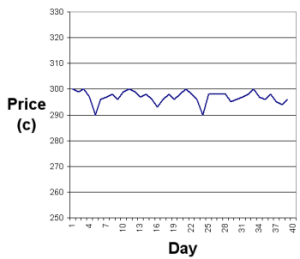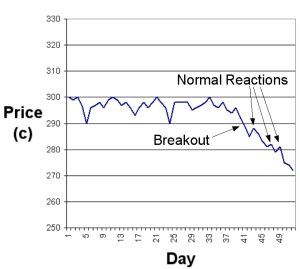GuestNewBoy
饭面全戒先行者 快乐逍摇任我......Jesse Livermore liked to trade stocks whose price was moving in an obvious trend. He was not interested in stocks whose price showed small price changes with no strong trend – such as the one in the chart below:

The stock price is stuck within a trading range.
The patterns he sought to identify were patterns in the prices. Modern traders – and indeed many traders in Livermore’s time too – plotted the prices and volumes against time on a chart. Jesse Livermore, however, did not use charts. He preferred to look at the numbers themselves.

The Pivotal Point
Jesse Livermore wrote:
Whenever I have had the patience to wait for the market to arrive at what I call a Pivotal Point before I started to trade; I have always made money in my operations.
Consider the chart below:
A pivotal point is reached.
The price had been trending downwards before rallying from a low of 40c.The rally could not be maintained, however, and the stock has retreated to 40c again. 40c has become what Jesse Livermore called a pivotal point. Any significant move either upwards or downwards from the pivotal point would be traded by Livermore.
If the stock were to break below, say, 37c, Livermore would sell short. If it were to break above, say, 43c, Livermore would buy. He would observe the price action carefully after the buy because 49c – the high of the earlier rally – is another pivotal point. If the price failed to rally above 49c – again by 3c, say – Livermore would exit from the trade.
Livermore said:
“I never benefited much from a move if I did not get in at somewhere near the beginning of the move. And the reason is that I missed the backlog of profit which is very necessary to provide the courage and patience to sit thourgh a move until the end comes – and to stay through any minor reactions or rallies which were bound to occur from time to time before the movement had completed its course.”
The Normal Reaction
Once a stock had broken out of a trading range – such as the stock below, which has broken downwards – Livermore would begin trading. In this case the breakout is downwards, so Livermore would sell the stock short.

Downward breakout from trading range.
He would look for signs that the new trend was behaving normally and that it would be safe to stick with the trade.
Jesse Livermore would look for the following signs:
• At the beginning of the move there should be an unusually large volume of shares traded.
• Prices should move generally in one direction (upwards or downwards) for a few days.
• A normal reaction should be observed – volume will decrease compared with the volumes observed during the initial trend, and the price may move against the trend somewhat.
• Within a day or two of the normal reaction, volume should increase again and the price trend should be resumed.
Provided this pattern is repeated, it is safe to stick with a trade. If there should be a deviation from the pattern, it is a warning sign. If the pattern fails and the price moves against the trend by more than a little, it is a sign to exit your trade and preserve your profit.




